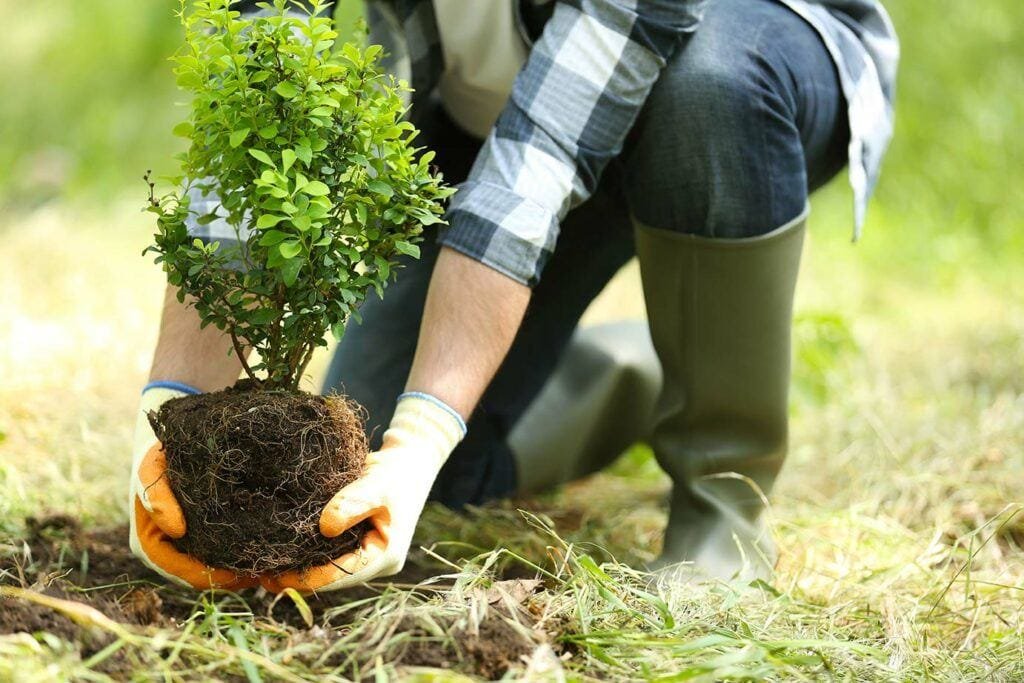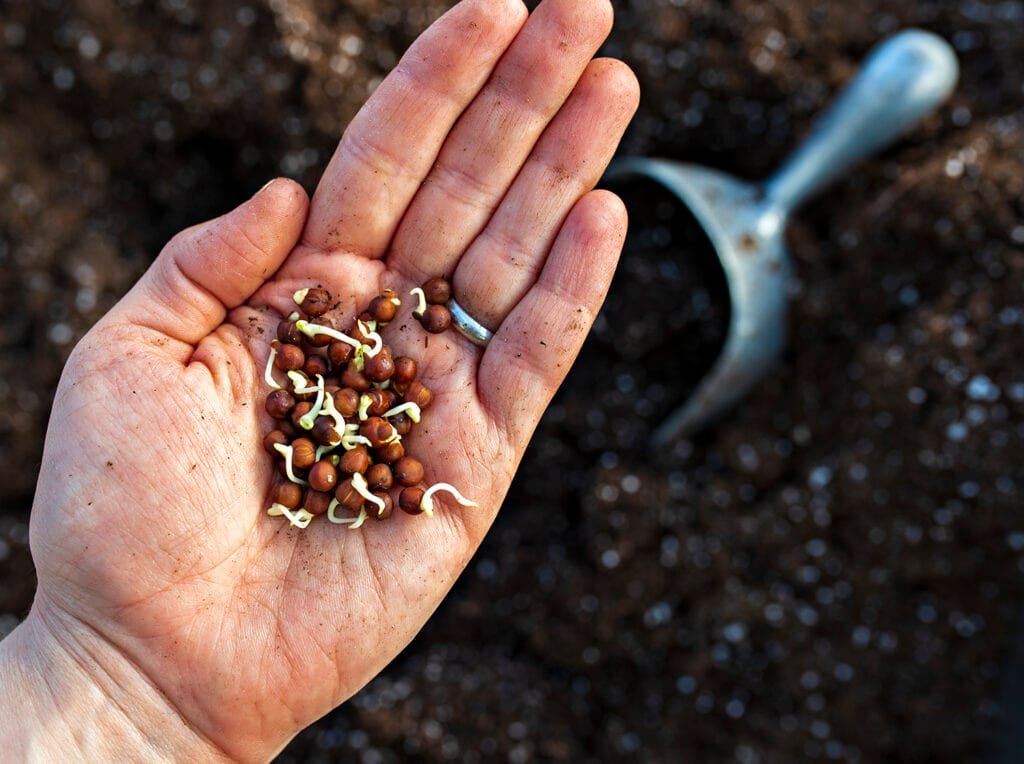Sowing refers to the process of placing seeds directly into the soil or a growing medium to initiate germination and plant growth. It involves selecting the right seed, preparing the soil, and ensuring proper depth, spacing, and environmental conditions (moisture, temperature, light) for successful sprouting.

Planting, on the other hand, is a broader term that includes:

- Transplanting young seedlings (grown in nurseries or trays) into their final growing location.
- Placing vegetative propagules (such as tubers, cuttings, or bulbs) into the soil to establish new plants.
- Directly sowing seeds, though this is more specifically termed “sowing.”
Table of Contents
Seed Sowing Techniques
1. Broadcasting
Broadcasting involves scattering seeds uniformly across the soil surface, typically done by hand or with a mechanical spreader. This method is commonly used for grasses, cover crops, and small-seeded vegetables like mustard or radish. Since seeds are not placed at precise depths or spacing, thinning is often required once seedlings emerge to prevent overcrowding. While broadcasting is quick and efficient for large areas, it can lead to uneven germination and competition for nutrients if not managed properly.
2. Drilling (Row Sowing)
Drilling is a systematic method where seeds are placed in straight rows using tools like seed drills, dibblers, or even manually with a hoe. This technique ensures consistent spacing between plants, making it easier to weed, water, and apply fertilizers. Row sowing is ideal for most vegetables (e.g., carrots, beans, and spinach) as it improves air circulation and sunlight exposure, reducing disease risks. The depth and spacing can be adjusted based on seed size and plant requirements.
3. Dibbling
Dibbling involves creating small holes (dibs) in the soil at predetermined spacing and dropping seeds into them. This method is particularly useful for larger seeds like maize, beans, or pumpkins, which need deeper planting. Dibbling ensures each seed has enough space to grow without competition and allows for precise placement in nutrient-rich spots. It is labor-intensive but highly effective for small-scale gardening or when using expensive hybrid seeds.
4. Transplanting
Transplanting starts with sowing seeds in a controlled nursery bed or seedling tray, allowing them to grow into sturdy seedlings before moving them to the main field. This method is beneficial for crops with long growing seasons (e.g., tomatoes, cabbage, and peppers) or those sensitive to early pest attacks. Transplanting gives plants a head start, ensures uniform growth, and extends the growing season in colder climates. However, it requires careful handling to avoid root damage during transplantation.
5. Hill Planting
Hill planting involves grouping multiple seeds (usually 3-5) in small mounds or raised soil patches. This technique is commonly used for vining plants like cucumbers, melons, and squash, as the mounds improve drainage, warm the soil faster, and provide space for sprawling growth. Once seedlings emerge, weaker ones are thinned out, leaving the strongest plant per hill. Hill planting is especially useful in heavy soils or areas with excessive rainfall.
Proper Spacing Guidelines
Proper spacing is critical to avoid overcrowding, which can lead to poor air circulation, increased disease risk, and competition for nutrients. Small plants like lettuce and radishes need 4-12 inches between plants to allow for leaf expansion and root development. Medium-sized plants such as bush beans and peppers require 12-24 inches to ensure adequate sunlight penetration and airflow.
Large crops like tomatoes and squash need 24-36 inches (or more) to accommodate their extensive root systems and foliage. Spacing also depends on whether plants are grown in rows, raised beds, or intensive intercropping systems. For example, square-foot gardening uses tighter spacing in grid patterns, while traditional row farming follows wider gaps for machinery access. Always refer to seed packet instructions for crop-specific recommendations.
| Crop | Spacing (Row × Plant) |
|---|---|
| Lettuce | 12″ × 6″ |
| Carrots | 12″ × 2″ |
| Tomatoes | 24-36″ × 18-24″ |
| Beans (Bush) | 18″ × 4″ |
| Corn | 30″ × 12″ |
| Cucumbers | 36″ × 12″ |
Factors Affecting Seed Germination
1. Water (Moisture)
Seeds absorb water during germination, which activates enzymes that break down stored nutrients for growth. Consistent moisture is essential, but overwatering can suffocate seeds by displacing oxygen in the soil, leading to rot. A well-draining soil mix or regular light watering helps maintain the ideal dampness. Mulching can retain moisture, but avoid thick layers that may block emerging seedlings.
2. Temperature
Each plant species has an optimal temperature range for germination. Cool-season crops like spinach and peas germinate best at 55–65°F (13–18°C), while warm-season crops like tomatoes and cucumbers require 70–85°F (21–29°C). Soil temperature matters more than air temperature; using a soil thermometer can help time sowing correctly. In colder climates, seedling heat mats or black plastic mulch can warm the soil artificially.
3. Oxygen
Respiration increases during germination, requiring oxygen to fuel metabolic processes. Compacted or waterlogged soils limit oxygen availability, stunting or killing seeds. Loose, well-aerated soil with organic matter (e.g., compost or perlite) ensures proper gas exchange. Avoid over-tilling, which can destroy soil structure.
4. Light
Some seeds (e.g., lettuce, petunias) require light to germinate and should be surface-sown or lightly pressed into the soil. Others (e.g., onions, beans) need darkness and must be buried deeper. Always check seed packet instructions for light requirements. Using a clear plastic cover can help retain humidity for light-dependent seeds while allowing light penetration.
5. Seed Depth
Planting depth is typically 2–3 times the seed’s diameter. Tiny seeds (e.g., carrots, lettuce) need shallow sowing (¼ inch deep), while large seeds (e.g., beans, sunflowers) can be planted 1–2 inches deep. Incorrect depth can prevent emergence—too deep, and seedlings exhaust energy before reaching light; too shallow, and seeds may dry out.
6. Soil Quality
A fertile, well-draining soil mix with compost provides nutrients and structure. Heavy clay soils should be amended with sand or organic matter to improve drainage, while sandy soils benefit from compost to retain moisture. Soil pH also matters; most crops prefer a pH of 6.0–7.0. Testing soil before planting helps identify necessary adjustments.
7. Seed Viability

Old or improperly stored seeds lose viability over time. To test germination rates, place 10 seeds on a damp paper towel, fold it, and keep it warm. Check after a week if fewer than 70% sprout, sow more densely or use fresh seeds. Store seeds in cool, dry, dark conditions to prolong viability.
Additional Tips for Better Germination
- Pre-soaking: Hard-coated seeds (e.g., peas, nasturtiums) absorb water faster when soaked for 12–24 hours before planting, speeding up germination.
- Scarification: Nicking or rubbing seeds with sandpaper (e.g., morning glory, lupine) breaks their hard outer layer, enabling water uptake.
- Stratification: Cold-loving plants (e.g., apples, lavender) require a chilling period (2–4 weeks in a fridge) to mimic winter and break dormancy.
- Mulching: A thin layer of straw or compost conserves moisture and regulates soil temperature but should be removed once seedlings emerge to prevent damping-off disease.
Frequently Asked Questions (FAQ)
What is sowing?
Sowing is the process of planting seeds in soil or a growing medium to grow new plants. It involves proper seed placement, spacing, and care to ensure successful germination.
What’s the difference between broadcasting and row sowing?
Broadcasting: Scattering seeds randomly (good for lawns, cover crops).
Row Sowing: Planting in straight lines (better for vegetables, easier maintenance).
Related Articles

